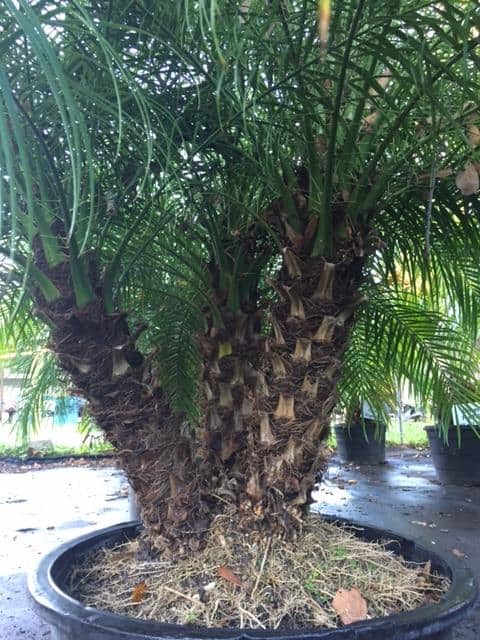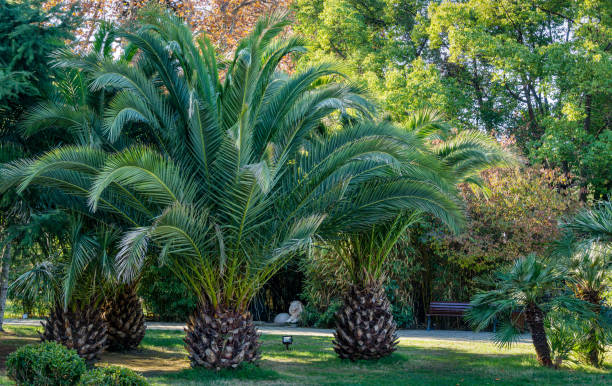Landscaping is an art form that allows homeowners to transform their outdoor space into a beautiful and functional oasis. While there are many different plants and trees that can be used in landscaping, one that stands out for its unique appearance and versatility is the pygmy date palm. In this article, we will explore the use of pygmy date palms in landscaping and provide tips, examples, comparisons, and advice on how to incorporate these stunning plants into your outdoor space.
What is a Pygmy Date Palm?

Before delving into the specifics of landscaping with pygmy date palms, it is important to understand what they are and why they are a popular choice for landscaping. Also known as the Phoenix roebelenii, the pygmy date palm is a small, slow-growing palm tree that is native to Southeast Asia. It typically reaches a height of 6-10 feet and has a compact, multi-stemmed trunk. The fronds of the pygmy date palm are feather-like and can grow up to 5 feet in length, giving it a tropical and elegant appearance.
How to Use Pygmy Date Palms in Landscaping

Using Pygmy Date Palms as a Focal Point
One of the most popular ways to incorporate pygmy date palms into landscaping is by using them as a focal point in your outdoor space. These plants have a striking appearance and can add a touch of elegance and tropical flair to any landscape. Planted alone or in groups, pygmy date palms can serve as a stunning centerpiece for your yard or garden.
Example:
A homeowner in a warm climate creates a small tropical oasis in their backyard using a combination of pygmy date palms, colorful flowers, and decorative rocks. The pygmy date palms are strategically placed around a small pond, creating a picture-perfect scene and serving as the focal point of the space.
Comparison:
Compared to other palm trees, such as the tall and slender coconut palm, the pygmy date palm is much smaller in size, making it a more suitable choice for smaller outdoor spaces. Additionally, the pygmy date palm is hardier and more resistant to pests and diseases, making it a more low-maintenance option for landscaping.
Pygmy Date Palms as Privacy Screens
Another way to use pygmy date palms in landscaping is by using them as privacy screens. Due to their full and bushy appearance, these plants can provide excellent coverage and create a natural barrier between your yard and your neighbors’. Planting a row of pygmy date palms along a fence or property line can add both function and beauty to your outdoor space.
Example:
A homeowner living in a suburban area uses pygmy date palms to create a private and tranquil backyard. They plant a row of pygmy date palms along the perimeter of their yard, providing privacy from their neighbors while also adding a touch of tropical charm to their landscape.
Comparison:
While traditional privacy hedges, such as boxwood or holly, require frequent pruning and maintenance, pygmy date palms only need occasional trimming to maintain their shape and size. This makes them a practical and aesthetically pleasing alternative for those looking for a natural privacy screen.
Pygmy Date Palms in Containers
For those with limited outdoor space or who want to add some greenery to their patio or balcony, pygmy date palms are an excellent choice for container gardening. These plants do well in containers and can be easily moved around to suit your design needs. This makes them a versatile option for those looking to incorporate plants into their outdoor space without having to commit to extensive landscaping.
Example:
A homeowner living in a high-rise apartment creates a small outdoor oasis on their balcony using potted pygmy date palms. The plants add a touch of greenery and tropical charm to the space, making it feel like a private retreat in the middle of the city.
Comparison:
Compared to other popular container plants, such as succulents or herbs, pygmy date palms are more visually striking and can provide a better contrast against the walls and floors of a balcony or patio. They also require less frequent watering and maintenance compared to delicate succulents, making them a practical choice for those with busy schedules.
Tips and Advice for Landscaping with Pygmy Date Palms
- When planting pygmy date palms, make sure to give them enough room to grow. These trees may be small when first planted, but they can reach up to 10 feet in height, so consider their mature size when choosing their location.
- Water pygmy date palms regularly, especially during the hot summer months. These plants prefer well-draining soil, so make sure to avoid overwatering.
- Fertilize pygmy date palms every 3 months with a balanced fertilizer to promote healthy growth.
- If planting pygmy date palms near a pool or water feature, make sure to regularly clean the fronds of any debris to prevent clogging and ensure the health of the plant.
- Consider pairing pygmy date palms with other tropical plants, such as bird of paradise or hibiscus, to create a cohesive and exotic landscape design.
FAQs

Are pygmy date palms suitable for all climates?
While pygmy date palms thrive in warm and humid climates, they can also do well in cooler regions if given proper care and protection from frost.
Do pygmy date palms produce edible fruit?
Yes, pygmy date palms produce small, edible fruits that are similar in taste to dates. However, they are not commonly sold commercially and are mostly enjoyed by birds and wildlife.
Can pygmy date palms survive indoors?
While these plants can be grown indoors, they do best when placed near a window where they can receive ample sunlight. They also require regular misting to maintain humidity levels.
How often should I trim my pygmy date palms?
Pygmy date palms only need to be trimmed 2-3 times a year, mainly to remove dead or damaged fronds. Avoid over-pruning as it can harm the plant.
Are pygmy date palms safe for pets?
While pygmy date palms are not toxic to dogs or cats, the sharp spines on their fronds can cause injury if ingested. It is best to keep pets away from these plants to avoid any potential harm.
Conclusion

Incorporating pygmy date palms into your landscaping can add a touch of tropical elegance to your outdoor space. From using them as a focal point to creating privacy screens or adding greenery to a small balcony, these versatile plants offer both aesthetic and functional benefits. With proper care and placement, pygmy date palms can thrive in a variety of climates and create a stunning and unique landscape design. So why not give them a try and see how they can transform your outdoor space into a tropical oasis?
